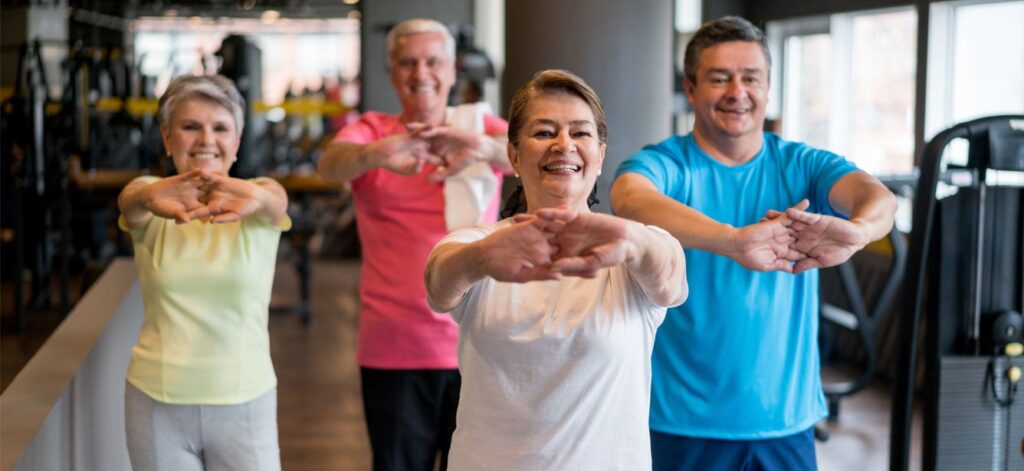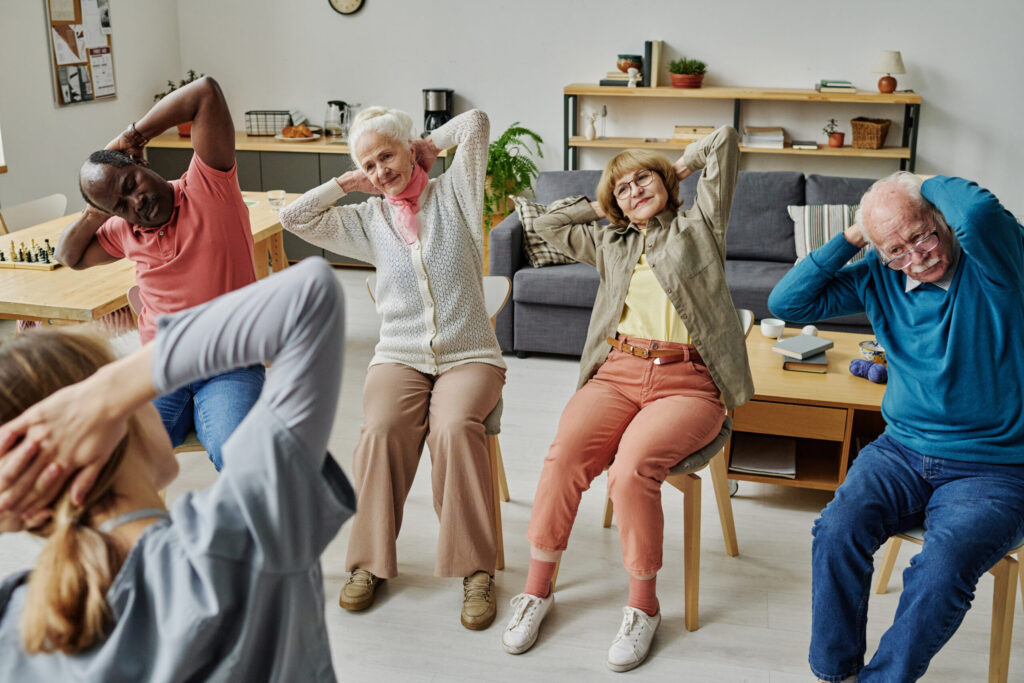Fitness for Seniors: Staying Active and Healthy in Later Life, As we journey through life, the significance of fitness only amplifies. For seniors, maintaining an active and healthy lifestyle is not just about looking good; it’s about preserving independence, enhancing well-being, and adding quality years to their lives. The benefits of fitness for seniors are profound and far-reaching, encompassing physical, mental, and social aspects. This comprehensive guide explores the multifaceted importance of fitness for seniors, offering practical advice, safe exercise recommendations, and strategies for overcoming common barriers to participation.
The Multifaceted Benefits of Senior Fitness:
The advantages of incorporating regular physical activity into a senior’s routine are undeniable. These benefits extend beyond physical prowess and deeply impact their overall quality of life:
- Improved Physical Health:
- Increased Strength and Mobility: Regular exercise, particularly resistance training, combats age-related muscle loss (sarcopenia), leading to increased strength, improved balance, and enhanced mobility. This allows seniors to perform daily tasks with greater ease, such as carrying groceries, climbing stairs, and maintaining their personal hygiene.
- Enhanced Cardiovascular Health: Aerobic exercises like walking, swimming, and cycling strengthen the heart and improve blood circulation. This reduces the risk of heart disease, stroke, and high blood pressure, all common concerns for seniors.
- Bone Density and Joint Health: Weight-bearing exercises stimulate bone growth, helping to prevent osteoporosis and reduce the risk of fractures. Low-impact activities can also help maintain joint flexibility and reduce pain associated with arthritis.
- Improved Balance and Coordination: Exercises that challenge balance and coordination, such as tai chi or yoga, help seniors maintain their stability and reduce the risk of falls, a leading cause of injury and hospitalization in older adults.
- Weight Management: Regular physical activity helps seniors maintain a healthy weight, reducing the risk of obesity-related conditions such as diabetes, heart disease, and certain cancers.
- Boosted Immune System: Moderate exercise can strengthen the immune system, making seniors less susceptible to infections and illnesses.
- Improved Sleep Quality: Regular physical activity can improve sleep patterns and reduce insomnia, allowing seniors to enjoy more restful and restorative sleep.
- Enhanced Mental and Cognitive Function:
- Improved Cognitive Function: Studies have shown that exercise can improve cognitive function, including memory, attention, and processing speed. It can also reduce the risk of cognitive decline and dementia.
- Reduced Risk of Alzheimer’s Disease: Research suggests that regular physical activity may help protect against Alzheimer’s disease and other forms of dementia. Exercise increases blood flow to the brain and promotes the growth of new brain cells.
- Mood Enhancement and Reduced Depression: Exercise releases endorphins, natural mood boosters that can help alleviate feelings of stress, anxiety, and depression. Social interaction during group exercise classes can also combat loneliness and isolation.
- Increased Self-Esteem and Confidence: As seniors experience the physical benefits of exercise, they often feel a greater sense of control over their bodies and their lives, leading to increased self-esteem and confidence.
- Social Benefits and Increased Independence:
- Social Interaction and Community Engagement: Joining exercise classes or walking groups provides opportunities for seniors to socialize with others, build friendships, and participate in their community.
- Increased Independence and Reduced Reliance on Caregivers: By maintaining their physical and cognitive abilities, seniors can remain independent for longer, reducing their reliance on caregivers and maintaining their autonomy.
- Improved Quality of Life: Ultimately, fitness for seniors contributes to a higher quality of life. By improving physical health, mental well-being, and social connections, seniors can live fuller, more active, and more fulfilling lives.

Safe and Effective Exercise Recommendations for Seniors:
Before starting any new exercise program, it’s crucial for seniors to consult with their physician to ensure they are healthy enough to participate. The following recommendations offer a balanced approach to fitness, encompassing different types of exercises that address various aspects of health:
- Aerobic Exercise (Cardiovascular Fitness):
- Walking: A simple and accessible exercise that can be easily incorporated into daily life. Start with short walks and gradually increase the duration and intensity.
- Swimming: A low-impact exercise that is gentle on the joints and provides a full-body workout.
- Cycling: Another low-impact option that can be done outdoors or on a stationary bike.
- Dancing: A fun and engaging way to improve cardiovascular health and coordination.
- Water Aerobics: A group exercise class that utilizes the buoyancy of water to reduce stress on the joints.
- Strength Training (Resistance Training):
- Bodyweight Exercises: Using your own body weight as resistance, such as squats, push-ups against a wall, and chair dips.
- Resistance Bands: Versatile and inexpensive, resistance bands can be used to work all major muscle groups.
- Light Weights: Using dumbbells or ankle weights to gradually increase resistance.
- Weight Machines: Weight machines at gyms provide controlled and supported resistance.
- Flexibility and Balance Exercises:
- Stretching: Gentle stretching exercises improve flexibility and range of motion, reducing stiffness and preventing injuries.
- Yoga: Combines stretching, strengthening, and relaxation techniques, improving flexibility, balance, and overall well-being.
- Tai Chi: A gentle form of exercise that improves balance, coordination, and flexibility.
- Balance Exercises: Simple exercises like standing on one leg or heel-to-toe walking can improve balance and reduce the risk of falls.

Overcoming Barriers to Senior Fitness:
While the benefits of fitness are clear, many seniors face challenges that prevent them from participating in regular physical activity. Recognizing and addressing these barriers is crucial for promoting successful and sustainable fitness programs:
- Lack of Motivation: It can be difficult to find the motivation to exercise, especially when dealing with age-related health issues.
- Strategies: Set realistic goals, find a workout buddy, reward yourself for reaching milestones, and focus on the positive feelings that exercise provides.
- Fear of Injury: Seniors may be concerned about getting injured while exercising.
- Strategies: Start slowly and gradually increase the intensity and duration of your workouts. Choose low-impact activities that are gentle on the joints. Work with a qualified fitness professional who can provide guidance and support.
- Health Conditions: Chronic health conditions such as arthritis, heart disease, and diabetes can make it challenging to exercise.
- Strategies: Consult with your physician to develop an exercise plan that is safe and appropriate for your specific health conditions. Choose activities that are tailored to your limitations. Listen to your body and stop if you experience any pain or discomfort.
- Lack of Access to Facilities: Seniors may not have access to gyms, swimming pools, or other fitness facilities.
- Strategies: Explore community centers, senior centers, and parks that offer free or low-cost exercise programs. Utilize online resources and videos that provide at-home workout options. Walking is a free and accessible exercise that can be done anywhere.
- Financial Constraints: The cost of gym memberships, personal training, and specialized equipment can be a barrier for some seniors.
- Strategies: Look for free or low-cost exercise programs offered by community organizations. Utilize bodyweight exercises and inexpensive equipment like resistance bands. Take advantage of outdoor activities like walking and hiking.
- Lack of Social Support: Seniors may feel isolated and unsupported in their efforts to exercise.
- Strategies: Join a walking group, exercise class, or senior center to connect with others who share your fitness goals. Enlist the support of family members and friends.

Tips for Creating a Sustainable Fitness Routine:
Consistency is key to reaping the benefits of fitness. Here are some tips for creating a sustainable fitness routine that you can stick with for the long term:
- Set Realistic Goals: Start with small, achievable goals and gradually increase the intensity and duration of your workouts. Don’t try to do too much too soon.
- Find Activities You Enjoy: Choose activities that you find fun and engaging, as you’re more likely to stick with them.
- Schedule Your Workouts: Treat your workouts like important appointments and schedule them into your calendar.
- Make it a Habit: The more consistently you exercise, the more it will become a habit.
- Listen to Your Body: Pay attention to your body’s signals and rest when you need to. Don’t push yourself too hard, especially when starting out.
- Track Your Progress: Keeping track of your progress can help you stay motivated and see how far you’ve come.
- Celebrate Your Successes: Reward yourself for reaching your fitness goals.
- Be Patient: It takes time to see results, so be patient and persistent.
- Find a Workout Buddy: Exercising with a friend can make it more fun and help you stay accountable.
- Consult with a Professional: A qualified fitness professional can provide guidance and support, helping you develop a safe and effective exercise program.

Conclusion:
Fitness for seniors is not merely about adding years to life; it’s about adding life to years. By embracing an active and healthy lifestyle, seniors can significantly improve their physical health, mental well-being, and social connections, leading to a more fulfilling and independent life. While challenges may exist, with the right approach, resources, and support, seniors can overcome these barriers and reap the countless benefits of regular physical activity. It’s never too late to start, and even small steps towards a more active lifestyle can make a profound difference in the quality of life for seniors. So, lace up those shoes, find an activity you enjoy, and embark on a journey towards a healthier, happier, and more vibrant life.
